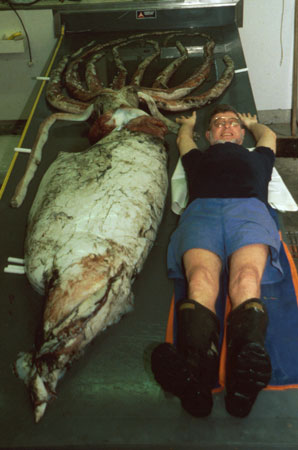September 26, 2007
Calculating History

I was remembering the robin’s egg blue TI-36 scientific calculator that I had before upgrading to the TI-82 graphing calculator. I envied those who had the newer TI-83, and the much coveted TI-83 plus, both of which played games. That’s when one of the inventors of the hand-held calculator, Jerry Merryman, took to the podium at a donation ceremony at the Smithsonian Castle yesterday, and guessed at my thoughts.
“Does anyone remember their first calculator?” Merryman asked his audience of curators, teachers and press.
Merryman, along with co-inventors James Van Tassel and Jack Kilby, invented the four-function, nearly three-pound personal computing device that replaced its typewriter-sized, 55-pound predecessor.
In celebration of the 40th anniversary of the 1967 original, Texas Instruments donated a TI-58 and 59, a TI-30, a TI-Navigator Classroom System and the new TI-Nspire handhelds and computer software to the Smithsonian’s National Museum of American History.
“Invention is a big part of American history,” says the museum’s director Brent Glass. “If you think about the history of technological education, it’s amazing what one little instrument has meant.”
(Courtesy of the National Museum of American History. Above, Jerry Merryman)
September 19, 2007
An Explosion of Color

Artist Morris Louis (1912-1962) produced 600 paintings in just eight years before succumbing to lung cancer at age 49. His method–to use acrylic paints to stain a canvas that hadn’t been primed so that the color seeped into the material–was an innovation that inspired a generation of artists. Tomorrow, a retrospective that includes 28 of his major works goes on view at the Hirshhorn Museum and Sculpture Garden.
In a gallery this morning, members of the press gathered before his 8 foot by 11 foot Point of Tranquility (1959-60) and the equally large Where (1960). Adjacent was Para III (1959), which was recently purchased by Atlanta’s High Museum of Art, where the show originated. On the opposite wall was the 8.5 foot by nearly 12 foot Number 99 (1959-1960). The four huge paintings popped with a wonderful, vibrant energy against the museum’s stark white walls.
“This room is an explosion of color,” says Smithsonian curator Valerie Fletcher, “when you put [these works] together they talk to each other.”
There’s certainly an expressive dialogue going on in that gallery, and the observer comes away a richer soul for having been witness to it.
(Courtesy of the Hirshhorn: Para III, 1959, Acrylic resin [Magna] on canvas, High Museum of Art, Atlanta, Gift of Marcella Louis Brenner.)
September 18, 2007
Encounter with a Humboldt

This summer, news reports rang with concern that the mighty Humboldt squid was expanding its home turf off the coast of California. Known to congregate in Baja’s Sea of Cortez, at least for the last 30 years, jumbo squid, up to seven feet long and weighing as much as 100 pounds, have been found in waters as far north as central California and southeast Alaska since the 1997 and 2002 El Nino episodes. Scientists note that the apparent range expansion could have something to do with climate-linked temperature changes in ocean water, the decline of predatory tuna and billfish populations and, as squid expert William Gilly of Stanford University’s Hopkins Marine Station hypothesizes, the Humboldt’s ability to inhabit a low-oxygen environment that excludes both their fish predators and feeding competitors.
Almost as equally debated is the squid’s temperament. Smithsonian cephalopod expert Clyde Roper from the National Museum of Natural History describes his aggressive run in with a Humboldt he lured into a cage some time ago while on a filming expedition in the Sea of Cortez:
“I was really interested in how her jaws worked, and I had this wonderful head-on view and her arms were splayed out so I could see the jaws at the base of her arms, the big lips. I think at some point she began to take exception to my examinations, and she just plain attacked without warning.
She was able to do this frontwards; this is the way they capture their prey, because they swim by jet propulsion. They take water into their body cavity, then seal the opening and contract the mantle, or body, and shoot the water out the funnel. But that funnel is very flexible so they can point it out beneath their head and it shoots them backwards or they tip it over, point it towards their tail and it shoots them forward. And that’s what she did at that point. It was just an instantaneous event. First of all, I didn’t have any place to go. I was in the chamber, and she just nailed me right on top of the thigh.
We were in [the water] for several more hours. Finally, at 3 o’clock in the morning, we’d had it and decided to go up on the boat. I had on a bathing suit, diving skins and a wetsuit. We all were ready to hit the sack so I stripped off my wetsuit, dive suit and bathing suit. All of sudden, the photographer looks over and says, ‘Clyde, what’s the matter with you?’ And I looked down and sure enough the blood was still running down out of the gash. The bite was around 2 inches long, right at the top of my thigh.
I could not call it an unprovoked attack. I had her in a cage she was unaccustomed to and I was hanging on to her. I never considered the fact that she was going to attack though. I was just interested in how she worked. And, well, I found out how.”
(Courtesy of Clyde Roper, measuring the length of a giant squid specimen.)
September 17, 2007
“Driven” to Create

Jacolby Satterwhite, a student at the Maryland Institute College of Art in Baltimore, cannot move his right arm. So, he uses his left arm to assist his right in painting. The 21-year-old painting major’s ingenuity, hard work and creativity haven’t gone unrecognized. His oil on canvas, Remission & Resilience (above), just earned him a $20,000 grand prize in an exhibition entitled “Driven,” which opened Saturday at the Smithsonian Institution’s S. Dillon Ripley Center.
“I think it [Remission & Resilience] was about my complexity of having illnesses and cancer. It can show up anytime, so I just continued to work and be resilient through these odds,” says Satterwhite, who lost mobility in his arm after a surgical procedure to treat bone cancer in his shoulder. “I was trying to create this piece about constant motion and activity, and I think it’s about the idea of work and conquering obstructions.”
Satterwhite created Remission & Resilience over the course of about two and a half weeks in 2006. The Columbia, South Carolina, native began painting while in high school at the South Carolina Governor’s School for the Arts and Humanities. Satterwhite mostly works with oil, painting pastoral landscapes and narratives centered around one metaphor, though he is dabbling in animation and sculpture.
On the recognition, Satterwhite says, “It was very encouraging, and I hope to be an advocate for artists who feel like they have something holding them back or a disability. I just feel it’s very rewarding in a testimonial sense. I am grateful, and I cannot wait to pursue projects, take care of my grad school applications and tuition with it [prize money]. I feel like it’s a blessing.”
“Driven” is co-sponsored by VSA Arts, an international nonprofit created to promote and showcase artists with disabilities, and Volkswagen of America, Inc. On view through to December 31, the exhibition will include the works of 15 emerging artists between the ages of 16 and 25 with disabilities.
(Courtesy of Jacolby Satterwhite, Remission and Resilience, oil on canvas)
September 13, 2007
A James Smithson Bobble Head?

Smithsonian founder James Smithson got air play this morning on local radio station 94.7, the Globe. The Weasel suggested that our man Smithson should be made into a bobble head.
Sure Weez. We’ll get right on that.






























